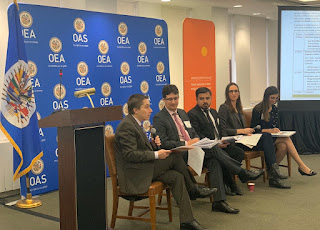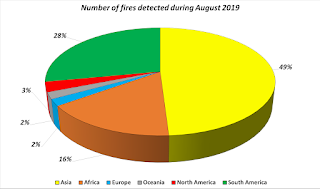Commemorating the International Day of Persons with Disabilities
This special edition conforms to the recommendations pertaining to the Digital Accessibility Toolkit for electronic communication. In this edition we removed the full justification from the text. We used built-in headings and styles, added more contrast for text and background colors, and used an alternative font (Times New Roman) and font size (12-point). Also we provided alternative text for most non-text elements, and a meaningful hyperlink text instead of ‘read more’.
Why It Matters
Large blocks without a justified text and a more accessible font can positively impact readability for someone with dyslexia. Also an adequate size and better contrast help users with low vision, color-blindness or when viewed on a black and white screen. People who use screen readers sometimes scan a list of links, the links should convey clear and accurate information about the destination.
World report on disability. About 15% of the world's population lives with some form of disability, of whom 2-4% experience significant difficulties in functioning. The global disability prevalence is higher than previous WHO estimates, which date from the 1970s and suggested a figure of around 10%. This global estimate for disability is on the rise due to population ageing and the rapid spread of chronic diseases, as well as improvements in the methodologies used to measure disability... World report on disability.
Including Children with Disabilities in Humanitarian Action. Worldwide, one in every 10 children has a disability – and the proportion is even higher in areas with armed conflict or disasters. Children and adults with disabilities are among the most marginalized people in any community affected by crisis. To make matters worse, they often are excluded from humanitarian assistance. But while crises put children with disabilities at risk, they can also create opportunities. Damaged buildings and infrastructure can be rebuilt better and more accessible than before. UNICEF has developed guidance to help make sure that children and adolescents with disabilities are included in all stages of humanitarian action – from preparing for emergencies to recovering from them... Including Children with Disabilities in Humanitarian Action.
 |
Hikmat and Abdullah are best friends – Zaatari refugee camp, Jordan
|
Making 'reasonable adjustments’ to help those living with disabilities to enjoy life to the fullest, while contributing with their special abilities. Two non profits whose mission is to empower people with disabilities:
We Elevate The Quality Of Life For Individuals Living With
Limited Mobility By Empowering Them To Train For And Participate In Mainstream
Running Events.
 |
| Athletes Serving Athletes Logo |
TEAM 360 is a non profit organization that provides
motivation and support to people of different abilities, empowering and
enabling them to train and participate in mainstream athletic events.
 |
| TEAM 360 Logo |
Interesting Facts
People with disabilities are being included in emergency drills — and exposing big flaws. More than 150 people from more than two dozen agencies took part in the Glen Rock drill, including police from Ridgewood, Hawthorne, Fair Lawn and the Bergen County Prosecutor’s Office. They stormed the train playing the roles of good guys and bad guys while fire and EMS crews prepared to help mock victims. Leotis Sanders, chief of civil rights and diversity program at NJ Transit, said these exercises are a vehicle for learning how to adapt. Verbal commands won’t help someone with a hearing impairment find an exit on a smoke-filled train. Opening train doors as an escape route won’t help mobility-challenged riders get out of harm’s way. Planners are noting these kinds of details with each new drill... People with disabilities are being included in emergency drills — and exposing big flaws.
 |
A group of people with
and without disabilities in an emergency drill
|
Emergency Preparedness for individuals with Disabilies. Recent disasters across the nation highlight the lack of critical community-based planning for people with disabilities and aging population. Ensuring individuals and emergency personnel are prepared prior to a disaster is recognized by FEMA and state and local officials as a key to community resilience. The emergency planning process requires accurate and comprehensive information by seasoned experts and is essential to the implementation of a successful plan. Learn how to keep yourself safe when disaster strikes... Emergency Preparedness for individuals with Disabilies.
Emergency Evacuation Planning Guide for People with Disabilities. The NFPA Emergency Evacuation Planning Guide for People with Disabilities has been developed with input from the disability community to provide general information on this important topic. In addition to providing information on the five general categories of disabilities (mobility impairments, visual impairments, hearing impairments, speech impairments, and cognitive impairments), the Guide outlines the four elements of evacuation information that occupants need: notification, way finding, use of the way, and assistance. Also included is a Personal Emergency Evacuation Planning Checklist that building services managers and people with disabilities can use to design a personalized evacuation plan. Emergency Evacuation Planning Guide for People with Disabilities.
 |
Guide's front cover
|
Readiness Workshop for People with Disabilities and the Access and Functional Needs Community ST. CROIX, U.S. Virgin Islands – The Governor’s Office, the V.I. Territorial Emergency Management Agency (VITEMA) and the Federal Emergency Management Agency (FEMA) led a Readiness and Resilience Workshop for People with Disabilities and the Access and Functional Needs Community in Christiansted... Readiness Workshop for People with Disabilities and the Access and Functional Needs Community
 |
Johanna Renzi assists Gerard Evelyn with creating a family communications plan
|
Policy Developments and Outlook
The United Nations Disability Inclusion Strategy, provides the foundation for sustainable and transformative progress on disability inclusion through all pillars of the work of the United Nations: peace and security, human rights, and development. The Strategy enables the UN system to support the implementation of the Convention on the Rights of Persons with Disabilities and other international human rights instruments, as well as the achievement of the Sustainable Development Goals, the Agenda for Humanity and the Sendai Framework for Disaster Risk Reduction....The United Nations Disability Inclusion Strategy,
Guidelines: Inclusion of Persons with Disabilities in Humanitarian Action. These guidelines set out essential actions that humanitarian actors must take in order to effectively identify and respond to the needs and rights of persons with disabilities who are most at risk of being left behind in humanitarian settings... Guidelines: Inclusion of Persons with Disabilities in Humanitarian Action.
Convention on the Rights of Persons
with Disabilities. The purpose of the present Convention is to promote, protect and ensure
the full and equal enjoyment of all human rights and fundamental freedoms by
all persons with disabilities, and to promote respect for their inherent dignity.
Persons with disabilities include those who have long-term physical,
mental, intellectual or sensory impairments which in interaction with various
barriers may hinder their full and effective participation in society on an equal
basis with others... Convention on the Rights of Persons with Disabilities.

























